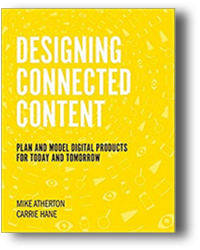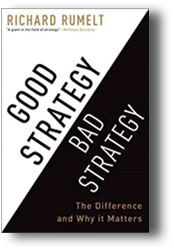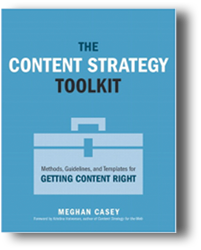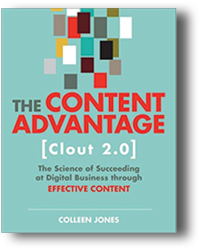By Kit Brown-Hoekstra and Alyssa Fox, Guest Reviewers
Introduction
For this special issue on content strategy, we selected several books that examine different aspects of content strategy and that would appeal to both novice and expert content strategists. Richard Rumfelt’s book, Good Strategy, Bad Strategy, takes a look at corporate strategic initiatives and shows us why so many of them fail. He then tells us how to build good strategies. Colleen Jones’s book, The Content Advantage [Clout 2.0], helps us build the business case and does a great job of discussing the metrics that upper management might care about. Mike Atherton and Carrie Hane show us how to create a content strategy in their book, Designing Connected Content. Last but not least, Meghan Casey’s book, The Content Strategy Toolkit, gives us practical advice and loads of job aids to help us build our content strategy. Each of these books belongs on your bookshelf, and all are great references.
Designing Connected Content: Plan and Model Digital Products for Today and Tomorrow (Reviewed by Kit Brown-Hoekstra)
 Reading Designing Connected Content: Plan and Model Digital Products for Today and Tomorrow felt like I was talking to my favorite teammates and geeking out on a topic that we love. I found myself writing “YES!” in the margin on every other page. Atherton and Hane are irreverent, knowledgeable, practical, and conversational as they walk the reader through the process of learning about a domain and then creating a content model and taxonomy to support it.
Reading Designing Connected Content: Plan and Model Digital Products for Today and Tomorrow felt like I was talking to my favorite teammates and geeking out on a topic that we love. I found myself writing “YES!” in the margin on every other page. Atherton and Hane are irreverent, knowledgeable, practical, and conversational as they walk the reader through the process of learning about a domain and then creating a content model and taxonomy to support it.
I loved how they snuck the human side of change management into their design process and how they kept the process practical. Using the IA Summit as an example to walk the reader through the process lent a familiarity to it that crossed industries because most people have been to at least one conference. The shared frame of reference reduces the cognitive load so that the reader can focus on the new concepts without getting hung up on specific industry requirements.
At its best, modeling is technology agnostic and considers not just the current need but also future needs of the content. By starting with the big picture of domain modeling and making it a visual map instead of a spreadsheet, Atherton and Hane help the team work together to define the boundaries and scope of the project, while also identifying areas where the project connects to other, related domains. The domain model can then be used to inform every aspect of the project. It is akin to the object-oriented design found in software development, and this parallel comes in handy when you need to talk to the database administrator to set up your content management system.
The content model arises from the domain model, and Chapter 6 does a great job of showing how the two models relate to each other and of explaining how the decision-making process might work in practice. By breaking it down into easily digestible chunks and using their experiences to illustrate the points, they make information architecture and content strategy accessible to a broader audience. And every technical communicator should be able to do a basic content model.
The second half of Designing Connected Content focuses on extrapolating the content model into structure and templates, and then publishing the content. They beat the “one resource per topic” drum and explain why this is important for re-use and content management, as well as why chunking helps you manage workflows and maximize re-use. Each chapter in this half moves deeper into the process of creating content and getting it into the wild. Chapter 10 wraps things up with their lessons learned, developing a business case, and metrics.
While their focus was Web content, this book is equally applicable to any content project, and the book would be even stronger with more technical communication examples.
Designing Connected Content should be on every technical communicator’s bookshelf, and students would find this an accessible introduction into content modeling.
Good Strategy Bad Strategy: The Difference and Why It Matters (Reviewed by Alyssa Fox)
 Today, most organizations hardly have time to breathe, steeped in transformation efforts and doing more with less. Unfortunately, that results in mediocre outcomes.
Today, most organizations hardly have time to breathe, steeped in transformation efforts and doing more with less. Unfortunately, that results in mediocre outcomes.
How did we get here? Rumelt argues that it’s a lack of strategy. We set goals, create mission statements, and build tactical plans as substitutes for strategy, doing what’s fastest and easiest to get to the next step. These attempts are bad strategy, avoiding the difficult choices we must make to navigate constraints we face.
In contrast, the essential components of good strategy form a “kernel.” The kernel includes a diagnosis of the challenge before you, a guiding policy for that challenge, and coherent actions to carry out the guiding policy. Too often, we bounce off to fix a problem, before taking the time to thoroughly understand the problem itself. Much of strategy work is trying to discern what’s going on, and most people don’t dig deeply enough.
The guiding policy is what most people currently call strategy. There’s an element of truth to that, but the policy can’t stand on its own. Without diagnosis, Rumelt questions how you can explore alternative policies. Guiding policies should create or draw upon sources of advantage.
Action is the kernel’s final aspect. Everyone loves to “do” things, but if you don’t have a solid diagnosis and strong guiding policy, you’re heading in the wrong direction. The hardest part of the coherent action is picking the right actions to do with the right priority. Strategy is more about what “not” to do than what to do, and this realization can be startling.
Good Strategy Bad Strategy: The Difference and Why It Matters includes dozens of examples from business, government, and history. While some examples were almost tediously long, most of them were profound peeks into the successes, and more often, the failures, of various groups building good or bad strategy into their work.
My one disappointment in the book surrounds the Part III section, “Thinking Like a Strategist.” It was disconnected from the rest of the book’s style, rambling, and just not useful. There’s no real new information in this section, and the gems are found in Parts I and II.
Overall, Good Strategy Bad Strategy is a timely, relevant read. Though many of the case studies stem from business, it’s applicable to other groups, as well as individuals looking to achieve goals successfully. This book is indispensable for those who want to not only better understand strategy but build strategies.
The Content Strategy Toolkit: Methods, Guidelines, and Templates for Getting Content Right (Reviewed by Kit Brown-Hoekstra)
 The Content Strategy Toolkit: Methods, Guidelines, and Templates for Getting Content Right is a how-to content strategy guide and includes downloadable content from Peachpit’s website, starting with building your business case and finishing with governance and lifecycle considerations.
The Content Strategy Toolkit: Methods, Guidelines, and Templates for Getting Content Right is a how-to content strategy guide and includes downloadable content from Peachpit’s website, starting with building your business case and finishing with governance and lifecycle considerations.
Most sections include a side bar that describes how to use one of the downloadable tools, such as discovery insights workbook, the stakeholder interview guide, the content audit spreadsheet, and more. In addition, margin notes and tips abound. Casey’s style and tone are comfortable and friendly, which makes the book an easy read and makes the content accessible for even a novice content strategist.
However, even experienced content strategists will find tidbits they can use. It’s always useful to hear how other people handle discovery and stakeholder interviews, and to get ideas for group exercises and change management. As a specific example, I found it interesting that her content audit spreadsheet is very similar to the one I use. I will be taking a closer look to see where I can make improvements.
The downloadable tools and job aids alone are worth the book’s cost. The appendix lists all the tools and maps them to where they are discussed. Combined with the logical, workflow-based organization and the clear instructions, this is a book every technical communicator should have and refer to regularly.
Like most content strategy books, my biggest criticism is that it’s overly web-focused. The principles and techniques described in The Content Strategy Toolkit apply to many kinds of content. It would be great if we could get away from the output format focus and look more at the function of the content within the company’s content ecosystem. I hope that future books do this.
The Content Advantage [Clout 2.0]: The Science of Succeeding at Digital Business through Effective Content (Reviewed by Kit Brown-Hoekstra)
 Jones makes the business case for content as a core competency for every business. To achieve content maturity in her model, companies need to invest in centralized content operations on par with other upper executive (C-level) functions.
Jones makes the business case for content as a core competency for every business. To achieve content maturity in her model, companies need to invest in centralized content operations on par with other upper executive (C-level) functions.
The best aspects of The Content Advantage [Clout 2.0]: The Science of Succeeding at Digital Business through Effective Content include hard data that content professionals can reference when building their own business cases. In addition, chapters 8 and 9 focus on building a content intelligence system (metrics) for determining how your content is performing, and, in turn, informs your business decisions about your content. Jones defines content intelligence as “a system of collecting data related to your content and turning it into insight for content decisions and more” (p. 130). Many, if not most, content organizations do a mediocre job at measuring success and these chapters point to more effective practices that an organization can use to quickly improve. This intelligence helps us speak the C-level’s language more effectively.
Consequently, the book’s primary audience is the director and manager level in an organization—the people responsible for funding and leading content strategy and implementation efforts. It focuses more on the “why,” the “what,” and the results than on the “how,” though Jones extensively references other books and resources that do cover the “how.” (Appendix C categorizes the resources mentioned into a convenient list.)
The Content Advantage [Clout 2.0] is intended to guide you in developing a roadmap for your organization, from vision to maturity. Throughout, Jones emphasizes the importance of data analysis to inform your content strategy and how vital it is that upper management fully embrace and support the effort to create a mature organization. She does a good job of identifying where the needs of enterprise level companies differ from those of small– and medium–sized businesses. The examples, data, and resources reinforce her points.
With its focus on web and marketing content, the book glosses over discussing ways to bring technical communication and localization into the mix. For example, when chapter 7 discusses metaphor, it is a perfect opportunity to bring in the importance of cultural considerations in using metaphor. Yes, metaphors are important for helping map the audience’s background and knowledge to the new thing you are introducing. However, metaphors tend to be culturally specific, which can cause issues with adoption if you aren’t careful. Chapter 11 could have done a better job of mapping skills that many technical communicators already have to the new roles she is proposing in the content organization, with the most obvious ones being the content engineer and content designer, areas where technical communication teams are typically ahead of marketing communication teams in maturity.
Overall, The Content Advantage [Clout 2.0] is an excellent resource for consultants and managers to help their organizations develop into mature content organizations.
About the Author
Kit Brown-Hoekstra is an STC Fellow and former Society President, and award-winning consultant. As Principal of Comgenesis, LLC, Kit provides consulting to her clients on localization and content strategy. She speaks at conferences worldwide and publishes regularly in industry magazines. She recently edited The Language of Localization.
Alyssa Fox is a content strategist and marketing leader who thrives on improving customer experience through brand consistency, relevant content, and integrated sales and support. She’s an STC senior member and currently serves as the Immediate Past President and Nominating Committee Chair.
References
Atherton, Mike, and Carrie Hane. Designing Connected Content: Plan and Model Digital Products for Today and Tomorrow. 2018. Berkeley, CA: New Riders. [ISBN 978-0-13-476338-5. 222 pages, including index. US$34.99 (softcover).]
Casey, Meghan. The Content Strategy Toolkit: Methods, Guidelines, and Templates for Getting Content Right. 2015. San Francisco, CA: New Riders/Peachpit. [ISBN 978-0-134-10510-9. 235 pages, including index. US$34.99.]
Jones, Colleen. The Content Advantage [Clout 2.0]: The Science of Succeeding at Digital Business through Effective Content. 2019. San Francisco, CA: New Riders/Peachpit. [ISBN 978-0-13-515932-3. 230 pages. US$34.99.]
Rumelt, Richard P. Good Strategy, Bad Strategy: The Difference and Why It Matters. 2011. New York, NY: Crown Business. [ISBN 978-0-3078-8623-1. 336 pages, including index. US$29.95.]
Table 1: Books On Content Strategy Compared
| The Content Strategy Toolkit | Designing Connected Content | The Content Advantage [Clout 2.0] | Good Strategy, Bad Strategy | |
|---|---|---|---|---|
| Audience | Beginner-Intermediate | Intermediate | Advanced | Intermediate-Advanced |
| Major Strengths |
|
|
|
|
| Major Weaknesses |
|
|
|
|
| Comments | Belongs on every technical communicator’s bookshelf, especially for anyone looking to transition into content strategy | Belongs on every technical communicator’s bookshelf, particularly if you are faced with developing content strategies and models specific to your domain | Excellent resource for anyone who needs to create a content strategy business case | Good resource for people who want to understand overall business strategy. The principles also apply to content strategy. |
| Rating (5-star scale) | ***** | **** | **** | *** |
| Cost (USD) | $34.99 | $34.99 | $34.99 | $29.95 |

